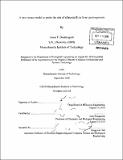A new mouse model to probe the role of aflatoxin B₁ in liver carcinogenesis
Author(s)
Bouhenguel, Jason T
DownloadFull printable version (8.647Mb)
Other Contributors
Massachusetts Institute of Technology. Dept. of Biological Engineering.
Advisor
John Essigmann.
Terms of use
Metadata
Show full item recordAbstract
One and a half million new cancer cases are reported each year in the United States. Despite this overwhelming burden of disease, current preventative treatments and early detection techniques are inadequate. With cancers, as with many aggressive diseases, time is of the essence; earlier detection begets better patient prognoses. While contemporary technology offers physicians the ability to battle cancers via stage-one detection, few reliable biomarkers have been developed to assist in detection of upstream tumorigenesis or interpretation of early genomic assault. The objective of the work described here is to identify early biomarkers specific to tumorigenesis, which correlate with initial genomic assault and subsequent mutation in the gpt-delta (B6C3F1) mouse model. The test compound used in this work is aflatoxin B₁, a known human carcinogen produced by fungal spoilage of food materials. Aflatoxin B₁ was one of the carcinogens used in the "training set" of compounds that defined the B6C3F1 animal model. My work had three goals with regard to upgrading this model as a tool for contemporary toxicology. In the first part of the thesis, a kinetic profile was generated of AFB 1-DNA adduct formation and removal. In the second part of the work, adduct levels and specific DNA damage patterns of males and females were compared (males are generally more sensitive than females to this and other toxins). Third, nursing mother mice were treated with two chemo-preventive agents in an attempt to determine if chemoprevention of the dam would lead to protection of her children. This thesis documents generation of a 48-hour time-course assessing adductburden in four-day-old B6C3F1 neonates. These burdens are measured in adducts per mega-base of genomic DNA (based on a single 6mg/kg dose of AFB₁). As previous studies show that 6mg/kg at this age results in near 100% liver tumorigenesis, this timecourse provides significant intuition for the onset and persistence of DNA damage. The results showed that AFB₁-N7-Guanine adduct formation maximized at two hours post dosing and then decreased rapidly; its FAPY derivative proved to be much more stable with time. A slight excess adduct burden was observed in males from 2-48 hours post dosing. Systematic differences in gene expression were observed in nursing female mother mice that were either treated or not with R,S-sulforaphane or D3T (3H-1,2- dithiole-3-thione). While minimal gene expression changes were observed in pups nursed by a 2mg R,S-sulforaphane treated dam, those nursing from a 5mg R,S-sulforaphane treated mother experienced much greater effects. At 300 umol/kg doses of D3T to the mother, no statistically significant gene expression profile alterations were observed in the pups. The work described here did not identify conditions in which a chemopreventive pattern of gene expression in the mother could be transferred efficiently to her offspring.
Description
Thesis (S.M. in Toxicology)--Massachusetts Institute of Technology, Dept. of Biological Engineering, 2010. Cataloged from PDF version of thesis. Includes bibliographical references (p. 50-54).
Date issued
2010Department
Massachusetts Institute of Technology. Department of Biological EngineeringPublisher
Massachusetts Institute of Technology
Keywords
Biological Engineering.